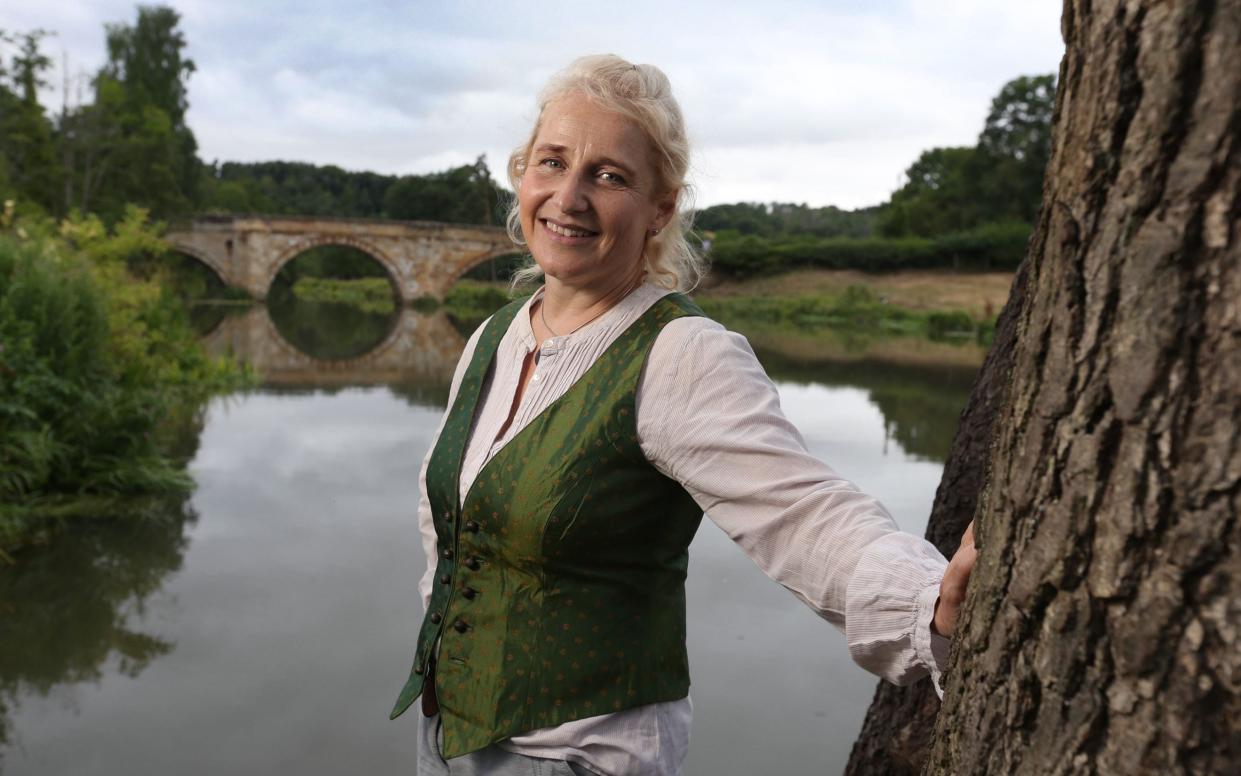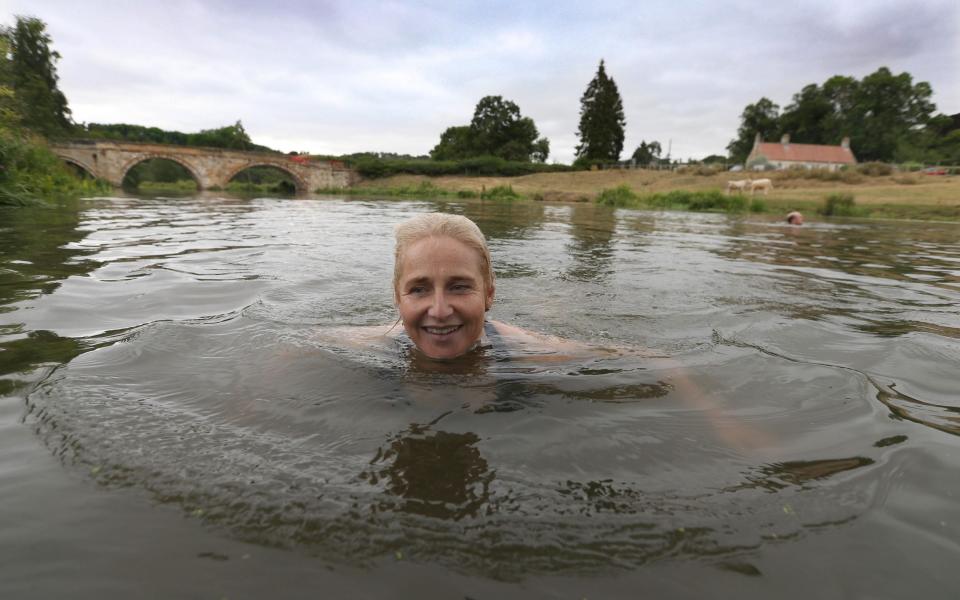‘We use our rivers as sewers and it's vile’: The author fighting for the future of Britain's waterways

I am swimming with Amy-Jane Beer in the River Derwent in North Yorkshire’s Howardian Hills. The ruins of the Augustinian Kirkham Priory stand on the opposite bank and sand martins and house martins skim the surface of water the colour of stewed tea.
Suddenly, the 51-year-old author and conservationist breaks off from a leisurely breaststroke, her attention attracted to a clump of foliage on the riverbank growing underneath the coiled roots of a gnarled alder. Pointing out the patch of water forget-me-nots, reeds and purple loosestrife, she says it reminds her of the famous depiction of Hamlet’s Ophelia by Sir John Everett Millais, floating dead in a stream, surrounded by flowers.
Nowadays, this is the speed at which Beer watches rivers. For her new book, The Flow: Rivers, Water and Wildness, she has swum, walked and followed a dozen or so waterways across Britain, from chalk streams to Welsh mountain torrents to the salmon runs of the Scottish Highlands. She has even visited the Hogsmill River, near Ewell in Surrey, where Millais set his Ophelia painting.
Beer’s book examines the reverential place rivers hold in our culture and the stories hidden in their depths. And as a conservationist and biologist (whose PhD at Royal Holloway examined the nervous systems of sea urchins), she also monitors the appalling extent to which the nation’s rivers are currently being polluted and abused.
But it was not always a relationship that ran at such a leisurely pace. On most weekends between 2002 and 2012, she could be found racing down a river in a kayak, as fast as the water would carry her.
It was on one such upland river, the Rawthey, at Sedbergh in Cumbria, where on New Year’s Day in 2012 a tragedy struck that altered the course of Beer’s life. That day, her friend Kate Stainsby, who was part of a close-knit group of kayakers, including Beer and her husband Roy, capsized in her canoe and became trapped under the water. The 41-year-old mother of one, who worked as a lecturer at York St John University, was airlifted to hospital in Preston, but died a few days later.

Beer says the loss of such a dear friend left her reeling. Even more so when a few months later another kayak-club member, Jason Raper, who had just completed a charity kayaking trip raising money for the air ambulance in Kate’s memory, also died, swept away on the River Raundalen, in Norway.
Suddenly, Beer found herself unable to go back on the water. As the mother of a young son (Lochy, now aged 11), she persuaded herself she had simply become more risk-adverse. But, she tells me as we sit by the banks of the River Derwent: “I have accepted now that what happened to Kate meant that the few times I did try and get on a white-water river after that, I would get an adrenalin rush, but it had weakened me. I couldn’t trust myself to make the moves I needed to.”
Parlous state
As she came to terms with the grief of losing her friend, she turned away from rivers. But, slowly, the currents drew her back. In October 2018, she visited the Rawthey for the first time at the spot where Kate’s accident occurred, taking with her a handful of hips and haws that she scattered in the water in her friend’s memory.
Then, on New Year’s Day in 2019, Beer visited the Rawthey to swim. The weather was so cold, she didn’t realise until she had pulled on her swimming costume that she had put it on the wrong way round, so she took it off, deposited it on the riverbank and swam naked through the icy water.
“I had thought it was going to be a powerful moment,” she recalls, “but then this wardrobe malfunction happened and I felt absurd and hilarious, and Kate was totally laughing with me. She was very much in my mind, then. All the solemnity of the occasion was gone and I was just alive.”
As well as exploring her own grief and the rivers of Britain, Beer laments the parlous state we find them in today. Figures published in 2020 revealed that just 14 per cent of English rivers are considered to be of a good ecological standard – the worst river quality in Europe.
The two largest contributors are agricultural pollution and raw sewage discharged by water firms – something that a Telegraph analysis, published as part of our Clean Rivers campaign, revealed happened for more than 3.1 million hours on 400,000 separate occasions in 2020 alone (despite water companies only legally being permitted to do so during periods of heavy rain).
“Mostly, it’s a book of wonder, but there are a couple of angry chapters that deal with the state of rivers and the lack of access to them,” Beer says. “I try and focus my anger. Impotent rage is a terrible thing.” Citing W H Auden’s famous lament that a culture is no better than its woods, she adds: “A society is no healthier than its rivers.”

Beer’s early childhood was the peripatetic life of an army family. Her father, Martin, was a major in the Royal Electrical and Mechanical Engineers and the family flitted between various bases in Germany and Britain. She was an avid reader of Arthur Ransome’s Swallows and Amazons, but the only rivers she encountered in real life were the “big, khaki, sluggish” motorways of the Rhine and Thames.
However, aged 11 on a family holiday in Watersmeet, in Devon, she visited the East Lyn River. It was while paddling there that she first encountered the dipper, a dainty white-breasted bird that inhabits upland rivers, which she had only previously read about in Swallows and Amazons. “This river was so alive and sparkling,” she recalls. “It was just a magical place.”
Beer revisited the East Lyn for her book and found it as beautiful as she remembered. However, her tours of other UK waterways have been far less gratifying. She mentions Bradford Beck, for example, which, though having recovered from its Industrial Revolution nadir, when the water was so filthy it could be set alight, is, under the surface at least, in a similar state of decline. Beer says a blue tint in the water (common in many UK rivers) is the result of chemical discharge, including from washing powders and raw sewage breaking down.
Like flying
In researching her book she has also snorkelled in rivers and watched sanitary towels and other flushed items floating past. “It’s just vile,” she says. “We are literally treating a river as a sewer and yet rivers are life.”
The Government announced in March that it plans to stop 40 per cent of untreated sewage releases by 2040, though Beer (along with many campaigners) is scathing of what she calls a meaningless target. “I’ll be 70 by then and it will still mean raw sewage being released into rivers for 1.5 million hours each year,” she says.
But despite encountering such environmental degradation, she remains entranced by the hidden life of rivers. She describes snorkelling in chalk streams as like flying over a landscape, marvelling at the caddisflies perched on the gravel beds in their protective cases.
Aside from the aforementioned dippers, she swam with brown trout and other river fish oblivious to her presence, while grey wagtails bobbed along the riverbanks and kingfishers flashed past. “They are birds that can literally make your heart jump, because you see them for such a short flash of time,” she says. “It’s like being defibrillated.”
Such encounters, alongside the coalition of citizens, scientists, anglers, swimmers and other river users campaigning for systemic change to improve England’s rivers, give her hope that these unique habitats can be preserved. “The hope is all we have,” she says. “Some might be too little, too late, but you have to do something.”
Since first visiting the Rawthey in 2018, Beer now goes back most years to honour her friend’s memory. Often, she will take an offering. This New Year’s Day, she took a home-made wreath of winter flowers she had hung on her front door over Christmas and dropped it in the river.
Now the book, which is dedicated to her friend, is finally published, Beer is contemplating taking a few pages in with her the next time she goes swimming in the river.
“The river is taking all the time from all of us and distributing something of us wherever it goes,” she says. “Kate’s memory is cherished, but it is also part of the past, and the future is what we have got to fight for, and with rivers, it is really in the balance.”
‘The Flow: Rivers, Water and Wildness’ by Amy-Jane Beer is available now, published by Bloomsbury Wildlife, £18.99

 Yahoo News
Yahoo News 
